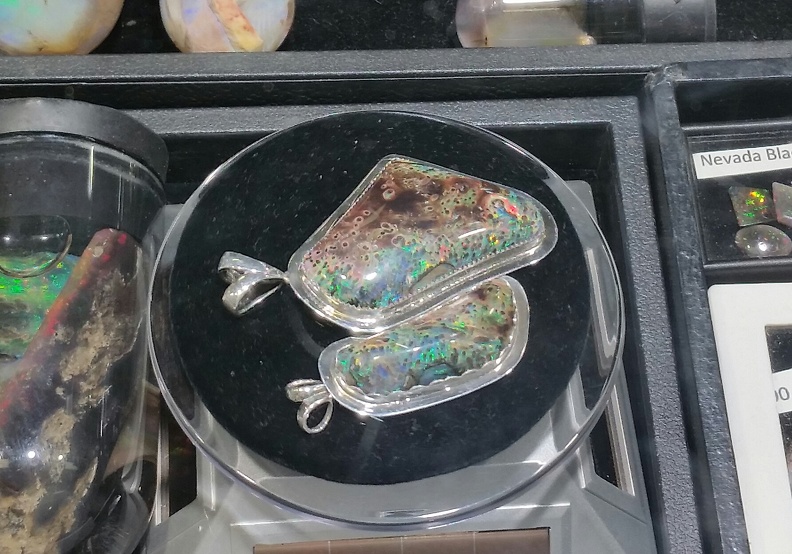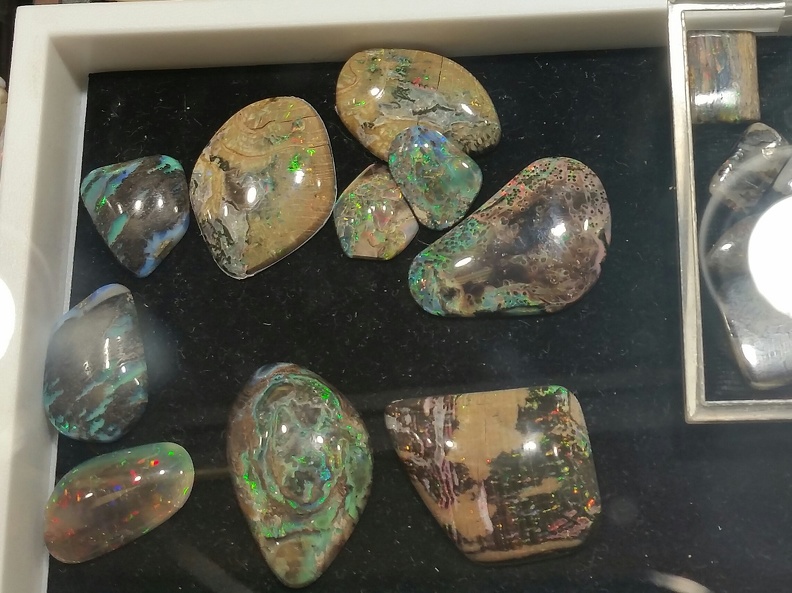|
|
Post by Peruano on Feb 17, 2019 19:04:39 GMT -5
Virgin Valley opal can be stable and can be spectacular. I've been helping a friend process some of the material from her father's mining efforts in Virgin Valley and can testify that it does not have to be kept in water to be stable and some pieces we have worked with are stunning. It appears to be opal in wood and the structure of the wood remains visible.  Some are as large.  |
|
|
|
Post by stonemon on Feb 17, 2019 19:15:50 GMT -5
Very nice material.
|
|
|
|
Post by fernwood on Feb 17, 2019 19:48:03 GMT -5
This combines two of my favorites. Wood and Opal. The colors in the Opal are stunning. The wood is a nice contrast.
|
|
|
|
Post by MsAli on Feb 17, 2019 20:15:06 GMT -5
Mother nature never ceases to amaze me
Those are gorgeous!
|
|
|
|
Post by hummingbirdstones on Feb 17, 2019 20:16:19 GMT -5
The opalized wood from Virgin Valley can be stunning, especially the Conch Conk wood. Beautiful pieces. Thanks for sharing them.
|
|
lookatthat
Cave Dweller  Whatever there is to be found.
Whatever there is to be found.
Member since May 2017
Posts: 1,360 
|
Post by lookatthat on Feb 18, 2019 10:43:00 GMT -5
Those are very cool pieces. They have so much character! Beautiful.
I bought a few rocks in a lot on ebay and one was a nice chunk of petrified wood. It's actually opalized, which it didn't mention in the listing, so -- bonus! I don't see any fire in the area that's exposed (the outside is bark)so there probably isn't any, and I'd hate to have it cut up to find out. It's a very solid piece.
|
|
gemfeller
Cave Dweller 
Member since June 2011
Posts: 4,060 
|
Post by gemfeller on Feb 18, 2019 14:38:26 GMT -5
The opalized wood from Virgin Valley can be stunning, especially the Conch wood. Beautiful pieces. Thanks for sharing them. Nice to see that material used in jewelry. Do you know the origin of the name? You write it as "conch" wood but I more often see it called "conk" as well. I know that "conch" is pronounced "conk," but which name came first for this wood? And more importantly, why? I see nothing conch-like about it. I'll bet there's an interesting back story. |
|
|
|
Post by hummingbirdstones on Feb 18, 2019 15:27:56 GMT -5
gemfeller I used the wrong spelling. It is conk. Thanks for the correction. 
From what I can gather, conks are shelf or bracket fungi (polypores) that grow on trees and consume them. Makes sense to me how the opal would form in the holes created and make the beautiful pattern of conk wood.
|
|
gemfeller
Cave Dweller 
Member since June 2011
Posts: 4,060 
|
Post by gemfeller on Feb 18, 2019 15:43:47 GMT -5
hummingbirdstones, thanks for the video. My comment wasn't meant as a correction. I hadn't bothered to check what a conk is. Thanks for the explanation. Somehow I had an image of a conch shell in my head and couldn't figure out the connection. FYI you can find Google images of the wood under both spellings.
|
|
|
|
Post by hummingbirdstones on Feb 18, 2019 15:56:23 GMT -5
Oh, I know you weren't correcting me. For some reason the only spelling I could come up with when I wrote the post was conch, and I kind of knew that was wrong and was too lazy to look it up. 
I have seen it spelled both ways, too, actually, but I think conk is the correct way in this instance. All those people using conch as the spelling were too lazy to look it up, too!  |
|
Sabre52
Cave Dweller  Me and my gal, Rosie
Me and my gal, Rosie
Member since August 2005
Posts: 20,496
|
Post by Sabre52 on Feb 22, 2019 9:06:31 GMT -5
My rockhounding buddy from Mariposa is a Virgin Valley addict. About ten years ago he bought an unsearched scoop from one of the mines and was rewarded with a bunch of big crystal opal limb casts that were full of fire. Largest must have weighed more than a pound. Incredible finds that made my jaw drop when I saw them. Never saw anything like that before except in books. One was even a little branchlet that was solidly replaced in crystal fire opal. I posted pics here at the time of the find but damn fuggin crooked ass photobucket took all my photos hostage.....Mel
|
|
|
|
Post by Peruano on Feb 22, 2019 10:08:28 GMT -5
I apologize for my poor photos, snapped in a display tray. I will try to get some better examples to share. I suspect there is a lot of Virgin Valley opal, that is cabbed and kept out of water, its just that it has been such a common statement and fear that it must be kept in water or it will craze. Especially the conk wood can be handled to allow dry mounts and use in exquisite jewelry. Lets see some more examples.
|
|
Deleted
Deleted Member
Member since January 1970
Posts: 0
|
Post by Deleted on Feb 22, 2019 12:08:32 GMT -5
I suspect there is a lot of Virgin Valley opal, that is cabbed and kept out of water, its just that it has been such a common statement and fear that it must be kept in water or it will craze. You are absolutely correct. Lots of it does crack, but even for those that do, there still can be great gems to be cabbed among the remaining shards. Some of the serious miners who aren't into bottling it up for specimens just spread the pieces out in the desert sun for a year or two before sorting it. On the other hand, holding a couple of hundred carats of perfect fireworks fresh out of the ground - well, it is difficult to want to risk seeing it craze. I also understand that dried pieces shouldn't be soaked again, as that risks crazing, too. Brief exposure to water (as in cabbing) isn't the problem, but letting sit in a bowl of water (let alone an ultrasonic bath) is a big no-no. As I've learned from personal experience, crazing can happen to opal from other areas, too, including Australian. Please do entertain us with more photos when you get a chance  |
|
zarguy
fully equipped rock polisher
   Cedar City, Utah - rockhound heaven!
Cedar City, Utah - rockhound heaven!
Member since December 2005
Posts: 1,791
|
Post by zarguy on Feb 22, 2019 12:30:30 GMT -5
Those are very cool pieces. They have so much character! Beautiful. I bought a few rocks in a lot on ebay and one was a nice chunk of petrified wood. It's actually opalized, which it didn't mention in the listing, so -- bonus! I don't see any fire in the area that's exposed (the outside is bark)so there probably isn't any, and I'd hate to have it cut up to find out. It's a very solid piece. There is a lot of opalized pet wood, but it's usually common opal, no fire. You can identify it by its glassy look. The opalized parts are lighter in weight & softer than usual. Lynn |
|
gemfeller
Cave Dweller 
Member since June 2011
Posts: 4,060 
|
Post by gemfeller on Feb 22, 2019 13:40:41 GMT -5
Many years ago I spent a week researching VV opal for an article I planned to write. I visited the Rainbow Ridge Mine owned by Keith Hodson and spent nearly a week digging with him. At that mine the opal occurs in a wet, sticky montmorillonite clay, as I think much VV opal does. He showed me how opal that's newly removed from the clay begins to craze almost immediately when exposed to air and sunlight. He held a new opal up to my ear and I could hear the crackling sounds.
He explained that VV opal contains about 20% water when mined while opal considered stable has about 1% water. The crazing occurs from immediate dehydration and the opal's structural inability to adust to that rapid change. But opal that's screened from mining spoils that have been out of the ground for a year or two is often stable. Very gradual water loss while being left in the clay leaves some of the opal intact and cuttable. At his mine at least, most stable opal is found by screening the spoils.
|
|
Deleted
Deleted Member
Member since January 1970
Posts: 0
|
Post by Deleted on Feb 22, 2019 14:37:10 GMT -5
Very gradual water loss while being left in the clay leaves some of the opal intact and cuttable. At his mine at least, most stable opal is found by screening the spoils. That's what the folks at Rainbow Ridge still say, and indeed I have some small dry limb pieces from the huge spoils piles at RR that haven't crazed after many years sitting in our low humidity. Digging in the spoils there is cheaper, too, if you don't mind moving a LOT of material around. Easiest (and more expensive) are the couple of mines that will dig out a backhoe bucket load of rich material to sort through as the friend of Sabre52 did. Remote, but worth the trip for anyone interested in opals. The high desert is beautiful, too - though there are times of the year to avoid when it gets too hot or too cold. |
|
|
|
Post by hummingbirdstones on Feb 22, 2019 15:11:22 GMT -5
That's on my bucket list to dig VV opal. Hopefully we'll be able to get up there and do it one year before we get too old and decrepit.
|
|
Deleted
Deleted Member
Member since January 1970
Posts: 0
|
Post by Deleted on Feb 22, 2019 18:56:56 GMT -5
That's on my bucket list to dig VV opal. Hopefully we'll be able to get up there and do it one year before we get too old and decrepit. Other than a few rental cabins, there isn't much in the way of accommodations nearby. The public campground at the entrance of the valley is one of my all-time favorites (hot spring fed pool and showers, and no fees), even though I'm decrepit myself. Fills up quick come evenings. May, early June are best times, IMO. High elevation, so cold nights and mornings. Starting to want to go again, myself. |
|
RWA3006
Cave Dweller 
Member since March 2009
Posts: 4,640 
|
Post by RWA3006 on Feb 22, 2019 20:00:51 GMT -5
I went there in August and roasted in the heat, but no regrets. Hope to go back soon. We found a few nice small pieces with great fire and I found a spectacular flashy black opal the size of a walnut. I'm addicted now.
|
|
|
|
Post by hummingbirdstones on Feb 22, 2019 20:59:31 GMT -5
I went there in August and roasted in the heat, but no regrets. Hope to go back soon. We found a few nice small pieces with great fire and I found a spectacular flashy black opal the size of a walnut. I'm addicted now. It's a disease. |
|


















